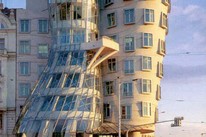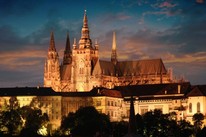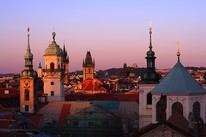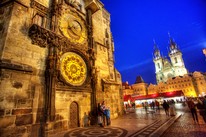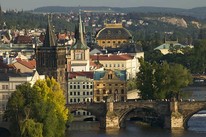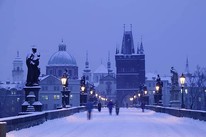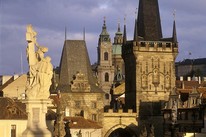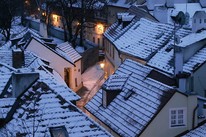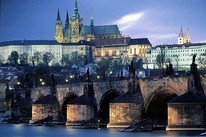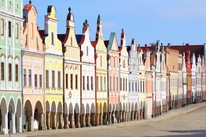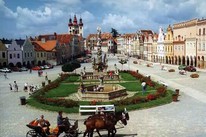UNESCO is the abbreviation of United Nations Educational, Scientific and Cultural Organization. In 1991 Czechoslovakia ratified the Convention Concerning the Protection of the World Cultural and Natural Heritage and since then a total of twelve sites in the Czech Republic have been inscribed in the World Heritage List. We can therefore proudly announce the Czech Republic to be a "UNESCO superpower".
By attributing the UNESCO symbol to a site, the entire world community is announcing: "Yes, this is something that is exceptional and unique in the world; it's something that we undertake to protect for each other and in the interest of us all - the nations of the world."
Prague - Historic Centre
On the UNESCO World Heritage List since 1992.
Prague is the most valuable urban conservation in the country. The historic core area of 866 hectares includes a unique urban complex consisting of Prague Castle and Hradcany, the Lesser Town including Charles Bridge, Old Town with Josefov (the preserved part of the former Jewish Town), New Town, Vyšehrad and their individual monuments.
Prague and its landmark Prague Castle´s historical and architectural developments rank among the most important monuments in Europe. They consist of a unique set of various architectural styles. Since Prague´s inception in the early Middle Ages it has been the center of secular and ecclesiastical power, and Prague Castle has been the seat of Czech kings and later presidents. The expansive New Town follows new architecture styles indicative of the artistic, social and cultural impact in Prague from the Middle Ages to the present.
Prague Castle
Prague Castle is the most important Czech castle and, according to the Guinness Book of Records, is the largest medieval castle in the world. It stands on a rocky peak above the Vltava river in Prague. From the 9th century on it was the seat of Czech princes, kings, and a Holy Roman Emperor; and since 1918 has served as the office of the president. Inside the castle there is St. Vitus Cathedral, a gothic church and sandstone monolith which was the traditional place of coronation for Czech kings and the final resting place for many of them. There, the beautiful Czech crown jewels are also stored.
The castle complex also houses the picturesque Golden Lane, which is formed by small houses with beautiful colorful facades that are embedded in a wall between the towers of the castle. These interesting houses became a refuge for a number of writers and artists who moved to the Golden Lane in search of inspiration. For example, house number 22 belonged to writer Franz Kafka in 1917 who wrote most of his stories from the collection The Country Doctor while there.
The beauty of the castle is truly spectacular. You can not only tour the beautiful and historic buildings, but can saunter through the six magnificent gardens that surround the castle complex. On the northern side you will find the most beautiful of them, the king's garden, which occupies the largest area and a former riding school. To the west stretches Garden on the Bastion and to the south side there are three gardens - Paradise, On the Ramparts and Hartig Garden. Lastly, Ochoz Garden surrounding the castle offers unforgettable views of the Golden City that is Prague.
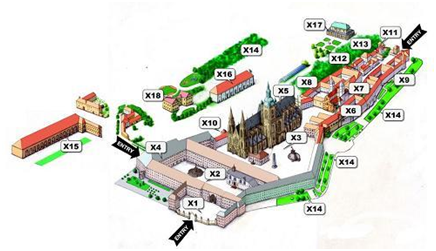
Telc
Telč is located in the southwestern tip of Moravia, halfway between Prague and Vienna. According to legend, the foundation of the city is associated with the victory of the Moravian Prince Otto II over the Czech Prince Břetislav in 1099. The winner established a church and village, and the fairytale town of Telč was born. Telč is the most perfect example of the Italian Renaissance north of the Alps and a town with one of the most beautiful squares in Europe. Due to this it was added to the UNESCO list in 1992.
The historic town center has maintained its charm reminiscent of yesteryear. The main town square is a unique complex of historical houses in the Renaissance and Baroque styles. In the center of town is also the original Gothic moated royal fortress from the 13th century which was transformed into a Renaissance chateau. It still contains luxurious interiors with unique decorations, period furnishings and valuable collections from its wealthy burgrave owners. You should consider taking a city tour with a commentary on the history and heritage of the city and a stop at the Oslednice viewpoint to get a wonderful view of the region. You will travel by an air-conditioned minibus that seats 9 persons.









